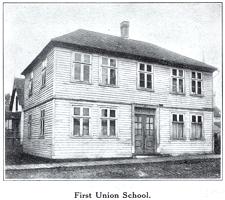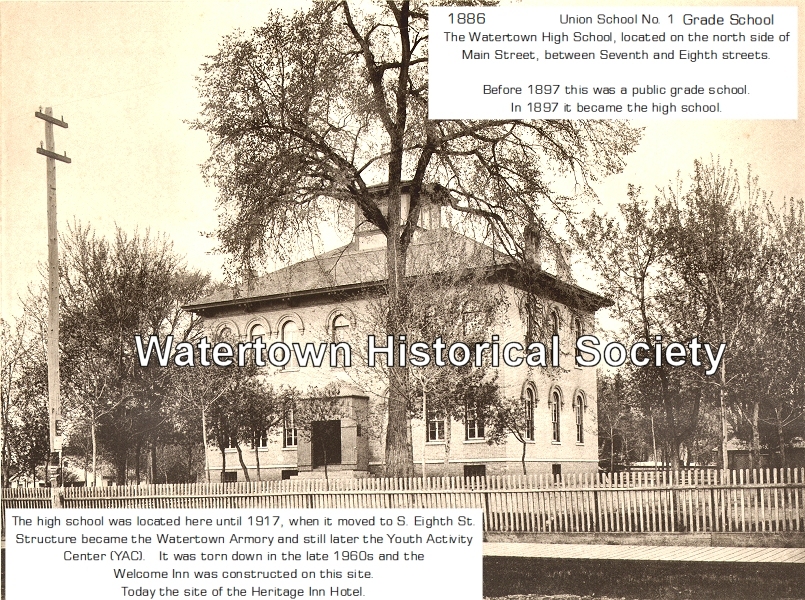website watertownhistory.org
ebook History of Watertown, Wisconsin
The Upper High School Grade from 1872-1876
Watertown High School Orbit, 1920
 From
1871 to 1873, two rooms on the upper floor of Union School, No. 1, later
remodeled to make the High School on
From
1871 to 1873, two rooms on the upper floor of Union School, No. 1, later
remodeled to make the High School on
The
First, or highest grade, taught by Bernhard, occupied the room which was the
west half of the second floor. The heating system for the room consisted of a
huge, drum topped box stove, behind which was a big pile of wood, and on the
other side zinc-lined shuttered screens, regulated by those sitting nearest.
Needless to say real comfort was somewhere midway between the stove and the
outside walls. Along the west wall, tall wooden cupboards concealed such
illustrative and experimental materials, such as mineralogical and geological
specimens, cases of mounted insects, a planetarium, a tellurian, a centrifugal
machine, a gyroscope, and electric friction machine, a Grove's battery, and an
air pump. At the blackboards, which covered three sides of the room, frequently
every bit of available space was occupied by eager pupils doing some assignment
of Mr. Bernhards.
Over these blackboards hung numerous maps and charts: in many studies these had to do the work of
the free text books, which were not introduced until 1877.
 Every
operation at the blackboard was closely watched by Mr. Bernhard, who demanded thoroughness
and exactness in everything. In fact, no
study was ever looked upon as finished, but could be brought up again when the
least expected. All the branches were co-related; and-whenever a weak spot was
discovered, the lesson under discussion was dropped until by means of drilling
and numerous other examples in subjects that gave additional light, all had
been made perfectly clear. And always the principles were the important things,
rules and theorems, easily derived from them were secondary.
Every
operation at the blackboard was closely watched by Mr. Bernhard, who demanded thoroughness
and exactness in everything. In fact, no
study was ever looked upon as finished, but could be brought up again when the
least expected. All the branches were co-related; and-whenever a weak spot was
discovered, the lesson under discussion was dropped until by means of drilling
and numerous other examples in subjects that gave additional light, all had
been made perfectly clear. And always the principles were the important things,
rules and theorems, easily derived from them were secondary.
Thus,
since it was general practice to have every branch well correlated and
thoroughly revived, the program was, of necessity a very flexible one, and if
at any, time during the day, interest seemed to flag, the lesson plan was never
too rigid to permit a few songs, with Mr. Bernhard at the organ.
Taken
as a whole, the course of study, as well as, the methods of teaching, aimed not
to fit the pupils for some higher institution of learning, but to give them a
"lucid perception of the general, natural and therefore necessary
connection of all branches of knowledge, and of all those scientific facts and
truths, which have a practical bearing upon moral, social, and civil
life" The knowledge imparted was to
be "popular, but not superficial, selective, but not fragmentary."
Besides
the regular curse of study, the high school also contained an incipient normal
department, which was taken advantage of by a considerable number of
non-residents, as well as those living in Watertown. This course included the
studies required by the law of the state for obtaining first, second and third
grade teachers' certificates.
The
first graduates, twelve in number, passed their examinations in 1873 and
received their diplomas a year or two later. But on this occasion there were no
graduation gowns; in those days linsey-woolsey was the popular material for
winter, and good strong calico for summer. There were no class colors, no class
yell; there were really no graduation exercises. To the twelve graduates,
standing near their benches, Mr. Bernhard made a few appropriate remarks, then
he handed each his diploma. That was all.
The
graduates were as follows:
Emma
Griffith, (Mrs. Frank Powers), Chicago, Illinois.
Emma Charboneau, (Mrs. J. B. Murphy),
Watertown, Wisconsin.
Jennie
Ross, Cleveland, Ohio.
Albert
Bellack, Columbus, Wisconsin.
Rosa Bernhard,
died in 1886.
Anna Shillcox, (Mrs. Thomas L. Smith), Milwaukee, Wisconsin.
Josephine Ruebhausen,
(Mrs. C. F. Viebahn), Watertown,,
Wisconsin.
Ida C.
Wilder, died in 1887.
Minnie
Voss, ( Mrs. George France), died in 1898.
Addie
Randall, (Mrs. James D. Baker), Eugene, Oregon.
Josie
Kern, (Mrs. Paul Fontaine), Minneapolis, Minnesota.
[ 11 are listed in Orbit article ]
Hope,
enthusiasm, joy, and good will dominated the spirit of the class of 1873. Going
to school was so great a delight that no weather was too inclement, no
snowdrift too deep. Such was the enthusiasm for learning that many continued to
go to school from one to three years after passing their final examinations, in
order to take advantage of the ever broadening curriculum. Their inspirer,
guide and friend, in praise of whom too much can hardly be said, was Theodore
Bernhard, teacher and scholar, who for many years so ably and faithfully
directed all educational matters in Watertown. His memory is held in the
highest regard by all who had the good fortune to come under his personal
instruction.
JOSEPHINE
A. VIEBAHN.
![]()
History
of Watertown, Wisconsin